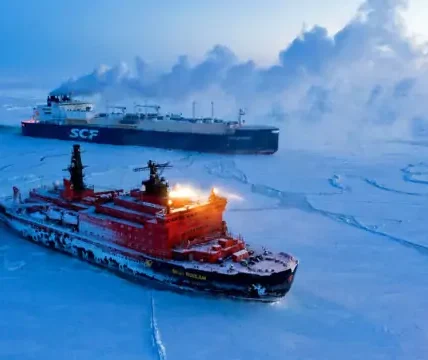Nuclear Waste Ship Makes Unprecedented Port Call at Novaya Zemlya
On September 29, Eye on the Arctic reported that the Russian ship Rossita was observed near Gremikha, a closed submarine base on the Kola Peninsula, before anchoring at Severny in Novaya Zemlya, a military settlement known for Russian nuclear tests. The Rossita, donated to Russia by Italy in 2011, is specifically designed to transport submarine fuel waste. (Eye on the Arctic)
Take 1: The safe management of nuclear waste, already a profound global challenge, has become even more pressing in light of Russia’s invasion of Ukraine. The Rossita is a reminder of a recent past where managing nuclear waste was a shared priority across Europe and beyond. Countries like France, Germany, Japan, Italy, and notably Norway, among others, joined forces to assist Russia in safely addressing over 20,000 spent nuclear assemblies from Soviet Era submarines. From 2017, the Rossita played a pivotal role in this endeavor, ferrying these assemblies between Andreeva Bay and Murmansk’s Atomflot port for reprocessing. For context, these improperly stored assemblies contain about double the uranium-235 found in the Chernobyl reactor. As communication between Russia and Western nations wanes post Ukraine’s invasion, Russia’s opacity on its nuclear transports is concerning. The recent reports on Rossita’s movements raise suspicions over a potential change in Russia’s nuclear waste management strategy. Frederic Hauge of the Norwegian Belladona Foundation cautions against premature conclusions but emphasizes the need for monitoring, especially regarding potential long-term storage plans in Novaya Zemlya’s permafrost. Given Russia’s significant nuclear assets, such as their nuclear-powered icebreakers and extensive submarine fleet, any unpredictability in their nuclear operations should be cause for global concern. (Belladona, The Barents Observer).
Nunavut Reviewing Its Language Laws for the First Time
On October 1, the CBC reported that the territorial government of Nunavut is reviewing its language legislation for the first time. The legislation —the Official Language Act (2013) and the Inuit Language Protection Act (2008) — were intended to have been reviewed every five years. The Acts mandate the use of Inuktitut, English, and French. (CBC)
Take 2: Nunavut’s public hearing on language legislation illustrates the urgency of prioritizing the use of Inuktitut in Nunavut and the structural issues that prevent it from having truly equal status with English, despite being an official language of Nunavut. Nunavut’s officials stated in the public hearing that use of Inuktitut has declined drastically—by almost 20% between 2001 and 2021—and that resistance from federal agencies to complying with the Inuit Language Protection Act is a serious issue for strengthening the use of Inuktitut. These developments can be seen in the wider contexts of the struggles of circumpolar Indigenous peoples to maintain language sovereignty that is not prioritized by settler colonial governments. As Joelie Kaernerk, Nunavut’s new Minister of Languages and of Culture and Heritage states, the departments and agencies that consistently refuse to comply with the language legislation are federal, and Nunavut lacks the legislative power to compel them. This refusal, along with French groups demanding increased Francophone services, points to deeper issues of jurisdiction and sovereignty. Despite establishing an Inuit-majority territory in 1999, the Canadian state has not recognized Inuit sovereignty as superseding its supposed federal jurisdiction. This means that territorial legislation cannot be effectively enforced on federal agencies and departments, whose employees constitute a significant demographic in the sparsely-populated territory. Similarly, the increasing push for French-language services and recognition in Nunavut shows that Indigenous sovereignty has not been recognized as having an impact on Canadian language policy equal to bilingual federal language legislation. The fourth official language of Nunavut, Inuinnaqtun, is the most endangered, and its less than 600 estimated speakers provide clear evidence of the urgent need to preserve and revitalize Indigenous languages in the Arctic. (CBC, Statistics Canada)
Nearly $30M Announced for High Arctic Housing Project in Canada
As reported by Nunatsiaq News on October 3, Canada’s federal government and the Qikiqtani Inuit Association (QIA) announced a joint commitment of nearly $30 million to boost housing in five High Arctic communities within Nunavut’s Qikiqtani region. The money will fund ten rental housing projects in the communities of Aujuittuq (Grise Fiord), Qausuittuq (Resolute Bay), Kanngiqtugaapik (Clyde River), Ikpiarjuk (Arctic Bay) and Mittimatalik (Pond Inlet). Upon completion, the projects are expected to provide a total of 21 three- or four-bedroom units. (Nunatsiaq News)
Take 3: The recent housing investment highlights the persistence of the ongoing housing crisis in Nunavut and other parts of Inuit Nunangat, Canada’s Inuit homeland. Since Inuit were forced into permanent settlements in the 1950s, insufficient and poor-quality housing has been a constant issue. Contemporary concerns include overcrowded homes due to housing development lagging behind population growth and rampant issues in existing houses, such as black mould, inadequate heating, and faulty sewage and plumbing systems, as documented in a 2021 report by then-Nunavut MP Mumilaaq Qaqqaq. Long-term living in poor-quality housing is resulting in a variety of issues such as mental health problems, domestic violence, and chronic illnesses that are not commonly seen outside the North (especially disproportionately high rates of tuberculosis). In some cases, children are removed from such homes and placed in non-Inuit foster care, instead of their parents being supported in accessing safer housing. In In 2022, Inuit Tapiriit Kanatami, the national representative organization for Canada’s Inuit, said it would take more than $3 billion over the next decade to construct needed new housing and maintain and repair existing homes in Inuit Nunangat.This means that the current investment of $30 million into only 21 units is not even remotely in keeping with the scale of the crisis, especially with the additional challenges of building in the Arctic, such as the high costs of labour and materials and limited transportation infrastructure. (CBC, Inuit Tapiriit Kanatami, Nunatsiaq News)
France’s Nuclear Submarine Docks in Tromsø, Shows Increased Commitment to Security in the Arctic
High North News reported on September 29 that a French Navy nuclear submarine and support vessel FS Garonne docked in Tromsø, Norway, as part of France’s deployment in the North Atlantic. This is the first known visit of a French submarine to Tromsø’s Grøtsund harbor since its designation as a port for allied reactor-powered vessels in 2020. The FS Garonne has been undertaking a three-month mission in the Arctic, collaborating on training activities in Canada, Greenland, and Norway. (High North News)
Take 4: France’s presence in Tromsø, a strategic port in the North Atlantic and the Arctic, signals the country’s resolution to play a prominent role in NATO naval operations. France’s three-month mission in the Arctic has focused on the issues of climate change and security. France has taken part in at least three naval exercises in the High Arctic this year, and is reportedly interested in signalling non-escalatory behaviour as well as NATO resolution and preparedness. Though France isn’t an Arctic nation, Arctic security and cooperation evidently remain high on France’s priority list. Their naval presence aligns with an escalating NATO footprint in the region, evidenced by exercises like the US-British-Norwegian joint training earlier this year. The stopover not only underscores Tromsø’s strategic importance for allies but also throws light on Norway’s controversial decision to allow nuclear vessels, a decision once rejected by its citizens. Even before Russia’s invasion of Ukraine, NATO submarines had been visiting Northern Norway several times a month, and lately it has seen US nuclear-powered submarines make port calls there. As Russia focuses on constructing more advanced nuclear-powered submarines and supporting its Northern Fleet, being able to monitor their submarines sailing out of the Kola Peninsula has in turn been a priority for NATO members. This development highlights the ongoing multinational cooperation in Arctic security training, and spotlights the importance of Norway for NATO allies: until earlier this year, it was the only NATO member country sharing a border with Russia. Russia-Norway relations have been a long-term concern for Norway, and use of Norwegian ports is essential for NATO capabilities in the North Atlantic and Arctic oceans. (High North News, Polar Journal, The Barents Observer)
Biden’s New 5-Year Offshore Oil and Gas Plan to Have Just Three Auctions
On September 29, The Washington Post reported that the Biden administration will approve just three offshore oil and gas lease auctions until 2029. Marking the lowest in history, this plan also stipulates further conditions: delaying the first lease until 2025 and confining new drilling operations solely to the Gulf of Mexico, excluding proposed leases in Alaska’s Cook Inlet. The Department of Interior emphasized that the plan was a step in acting on its commitment to support the offshore wind industry and transition away from fossil fuels. (The Washington Post)
Take 5: The Biden administration’s new offshore oil plan illustrates the challenges of navigating the fraught relationships with both environmentalists and fossil fuel industry groups. The administration is forced to announce new leases regardless of its own position because of a provision passed by Congress last year that requires the Department of Interior to approve offshore oil leasing to be able to do offshore wind leasing. Biden promised to end drilling on federal lands and waters, and emphasized transitioning to renewable energy sources and combating climate change in his election campaign. Yet, recent concessions to the oil industry have left many environmentalists and voters skeptical. While the administration has emphasized its support for renewable energy and prioritized investments in wind and solar power plants and electric car manufacturing, it has been far less consistent in phasing out support for oil and gas extraction. Earlier this year, the administration approved a new oil drilling project on Alaska’s North Slope—the biggest in Alaska in decades—while also protecting nearly 3 million acres of the Arctic Ocean from drilling. Oil drilling in Alaska, which has been in steady decline, is seen both as an opportunity for community investment and well-paying jobs and as a threat to caribou and Indigenous subsistence, but it shows that the US is not ready to move away from fossil fuels yet and that Alaska plays a central role in domestic oil production. (Arctic Today, High North News, PBS, PBS)




